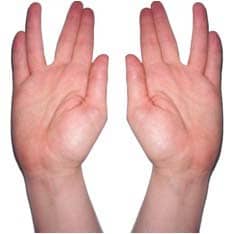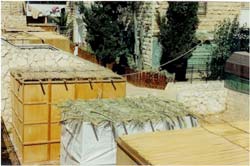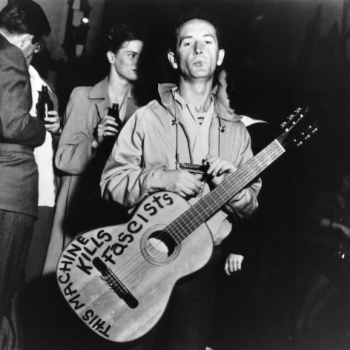By Talia Davis
The parasha (weekly Torah portion) for the week ending May 1 is Emor. Emor means "speak" in Hebrew and is the fifth word (and first distinctive word) in the portion. Be sure to check out the cartoons at the end for some great perspectives on these Torah portions.
Emor is a good name for Emor because there is a lot of "emor-ing" going on. G-d tells Moshe to talk to his peeps. This is the beginning of the formation of our Jewish community and like with all new communities, you have to set some ground rules. The first set of rules revolves around the High Priest, or Kohen Gadol, and his Kohanim (priests). They are rules like a Kohen cannot come in contact with a dead body and can't marry a woman who has been divorced. To this day, many people of Kohen descent follow these rules and will not marry a divorcee or a woman who is not a virgin. Other rules include not shaving heads or beards. Even if a man were born into the role of Kohen, by virtue of his tribe, if he were disabled he could not bring a sacrifice.
 Now on to the good part. Here G-d tells us about our holidays and what we are supposed to do. It starts with the sabbath, Shabbat! We hold it on the seventh day of every week (Saturday, not Sunday folks). Next is Pesach or Passover. This is a seven-day festival that happens on the 14th day of the first month (Nisan). But hey, wait just a minute. We celebrate eight days of Passover. Why is that? Ah, good observation. Outside of Israel, we celebrate eight days to ensure we are celebrating the right days. Short story -- back in the way back days, the Samaritans (they weren't always so good...) liked to be mean to the Israelites. We would light a fire on a high hilltop to let everyone know the festival was supposed to start. Well, the Samaritans would light a fire a day early to try to trick us. So a rule was instated that if you lived outside of the walled city (today considered all of Israel), you celebrate an extra day to be sure you got it right.
Now on to the good part. Here G-d tells us about our holidays and what we are supposed to do. It starts with the sabbath, Shabbat! We hold it on the seventh day of every week (Saturday, not Sunday folks). Next is Pesach or Passover. This is a seven-day festival that happens on the 14th day of the first month (Nisan). But hey, wait just a minute. We celebrate eight days of Passover. Why is that? Ah, good observation. Outside of Israel, we celebrate eight days to ensure we are celebrating the right days. Short story -- back in the way back days, the Samaritans (they weren't always so good...) liked to be mean to the Israelites. We would light a fire on a high hilltop to let everyone know the festival was supposed to start. Well, the Samaritans would light a fire a day early to try to trick us. So a rule was instated that if you lived outside of the walled city (today considered all of Israel), you celebrate an extra day to be sure you got it right.
Moving on, fifty days after Pesach is Shavuot. Shavuot is a holiday to commemorate the giving of the covenant from G-d to Israel at Mt. Sinai. We count the seven weeks between Pesach and Shavuot, and that is called the Omer. It is a very special time. On Pesach we were freed from slavery and on Shavuot we received the Torah.
Next up, Rosh Hashanah on the first day of the seventh month (1st of Tishrei) and Yom Kippur on the tenth day of the seventh month (10th of Tishrei). These are biggies. Rosh Hashanah is one of four Jewish new years. This one is the start of the civil year of the Hebrew calendar, and so it is the new year for people and animals and contracts. Not to mention, our year changes, like from 5770 to 5771. Once we celebrate the refreshing of our year, we have to remember and repent for the bad things we did in the last year. In Judaism, the slate is cleaned each year. No carryover sins. You are as sinless as a baby each year. There are ten days of repentance between Rosh Hashanah and Yom Kippur. It is after this repentance that we have the soul-refreshing, 25 hours of fasting, beat-on-your-chest-apologizing Day of Atonement.
 The last in the list of holidays that G-d lays out for us here is Sukkot. This happens five days after Yom Kippur on the 15th of Tishrei. It is this Hebrew month when most Jews are a bit busy. Sukkot is a nice holiday to relax with after all the apples and honey and prayer and repentance. But you have to build your sukkah first.
The last in the list of holidays that G-d lays out for us here is Sukkot. This happens five days after Yom Kippur on the 15th of Tishrei. It is this Hebrew month when most Jews are a bit busy. Sukkot is a nice holiday to relax with after all the apples and honey and prayer and repentance. But you have to build your sukkah first.
Sukkot is one of the three pilgrimage festivals (when everyone would go to the Holy Temple in Jerusalem) and therefore one of the only three holidays that are called a Chag, a festival. This is a seven-day festival, where again we celebrate eight days outside of Israel.
The day after Yom Kippur ends, sukkah building begins. A sukkah is a hut. It can be large or small, homemade or pre-fab, but there are rules. It must have three sides and a roof. But the roof can't be solid (i.e., no concrete); you must be able to see the stars through the roof. Slats are usually put up and s'chach is put on top. S'chach is one of those words you just have to hear. It is totally guttural. S'chach are palm fronds, tree branches, etc., that are not attached to a tree. Inside this structure, you hang decorations. This part is like our Christmas tree, only no fancy glass ornaments, usually. Popcorn strings, pomegranates, paper chains...




